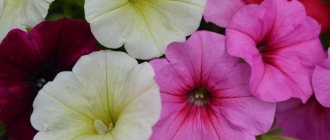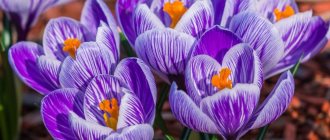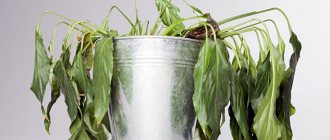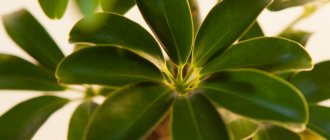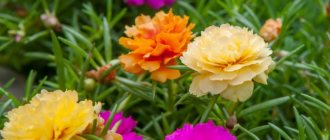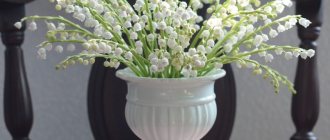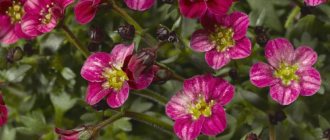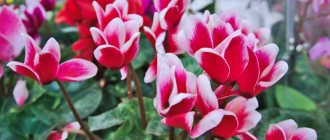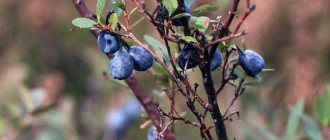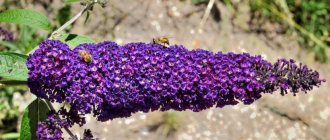We firmly associate the Jasmine flower with tea and aromatic garden shrubs (garden jasmine).
But, in fact, jasmine has nothing to do with the shrubs that grow in the gardens of central Russia. Mock orange grows in open ground, which is similar to jasmine only in the aroma of the flowers; otherwise, these are completely different plants belonging to different families. Real jasmine is an evergreen vine or shrub, which, due to its demanding and capricious nature, simply will not survive our winter and is grown here exclusively as a potted crop, which is the pride of any gardener.
Buy Jasmine seeds =>>
Symbolism of Jasmine
The noble white color and delicate aroma have been valued by people since ancient times. They associated them with nobility, grace and benevolence.
Thus, in Christianity, jasmine is considered the flower of the Virgin Mary. In China, Thailand and Indonesia, jasmine symbolizes femininity and purity.
Indonesians call it “melati” and actively use it, for example, at wedding ceremonies. Among the Tatars, jasmine is considered a sacred plant - to get to heaven, a person must grow jasmine.
Room temperature
Jasmine is not so demanding regarding this indicator, but it is still worth paying attention; the optimal differences on the thermometer are considered to be 21-25 degrees. During the cold season, numbers that drop below 16 degrees in the room will be critical; this can lead to irreversible consequences.
During the winter, different varieties of this flower are kept under special conditions, so preparation of the place for the plants begins in advance. To achieve the most effective flowering, all nuances must be strictly observed, otherwise this process will be short and sparse.
Medicinal jasmine
According to recent studies, the aroma of jasmine affects the nervous system, promoting the production of encephalins, resulting in a relaxed state. So it helps with insomnia and acts as an antidepressant.
Jasmine essential oil is an effective care product for dry, oily and sensitive skin. It improves blood circulation, helps with diseases of the respiratory, genitourinary and endocrine systems.
In addition, jasmine has proven itself in the treatment of headaches, liver diseases, and rheumatism.
Reproduction
The plant propagates vegetatively - by dividing the root system and semi-lignified apical cuttings, which have 3 internodes (2-3 pairs of leaves). In summer, cuttings of green shoots can be taken to propagate jasmine. Cut just below the leaf node.
- The lowest pair of leaves is removed, the remaining ones are cut in half.
- A cut of the cutting is dipped into powder - a stimulator of root formation, and then buried 2 cm in a moist mixture prepared from equal parts of universal soil and sand (vermiculite).
- After which the cuttings are covered with a transparent bag or plastic bottle to create greenhouse conditions.
- During rooting, the soil should be moist all the time, but not wet.
When signs of new growth appear, the seedlings can be transplanted into pots of fertile soil, several per pot, to produce a strong, bushy plant.
Jasmine in landscape design
Fragrant and easy to trim, jasmine is indispensable as a hedge. Low-growing varieties are successfully integrated into rockeries, alpine hills and ridges. Jasmine also looks great near bodies of water, reflecting picturesquely in the water.
Hydrangea and spirea go well with jasmine. Climbing plants with garden jasmine combine clematis, actinidia, and climbing roses.
Childhood and youth
Sarah (the singer's real name) was born in the fall of 1977 into the family of Lev and Margarita Manakhimov, Mountain Jews from Dagestan Derbent.
When the girl was born, her parents were already raising her two-year-old brother Tolya. Jasmine as a child
The parents were creative people: the father, Lev Yakovlevich, was a choreographer and choreographer, the mother, Margarita Semyonovna, worked as a conductor.
Jasmine's parents
Despite her surroundings, Sarah was not interested in music. If Anatoly went to music school for at least three years, then his sister was not even interested in instruments, although she could study any. But she loved to sing, and her grandmother supported this desire. In 2021, the woman passed away, and the singer recalled:
Throughout my childhood, youth, and even adult life, Grandma Sarah was there, teaching me everything she knew, caring for me, protecting me, passing on her worldly wisdom, her funny songs, the secrets of her recipes. We, grandchildren, will always remember the aroma of grandmother’s signature bread, her playful ditties and gentle hands...
Her passion for singing did not distract the girl from studying at school.
Sarah dreamed of becoming a translator and traveling with delegations around the world, so she diligently studied English. But it didn’t work out: the Derbent university did not have a foreign language department, and the parents did not want to let their daughter go to the capital. And she, on the advice of her mother, with whom she was very close, entered medical college. During these years there, the girl became a member of the KVN student team and realized that she liked performing on stage and seeing how people applauded her singing:
Our college was supposed to participate in the KVN game against the Derbent Music School. The artistic director of the medical team called me to perform all the musical parts at the competition. That’s how I discovered the stage for the first time, but then the main thing was that the doctors beat the musicians!
In 1996, when Sarah graduated from university, her mother died of illness. Having a hard time experiencing the loss of a loved one, the girl decided to leave for Moscow and enter the Gnessin State Music College. She began to study vocals with the famous teacher Natalia Andrianova.
Jasmine in her youth
Three years of hard training and rehearsals actually flew by in a flash, and Sarah, listening to Andrianova’s expert opinion, decided to develop her career as a singer. Moreover, even at the beginning of her studies, she accepted the courtship of businessman Vyacheslav Semenduev, who was 17 years older than her, but was very persistent in his courtship. Sarah became his wife in 1996, and at first it was Semenduev who sponsored the promotion of the aspiring singer.
Jasmine Chubushnik
Looking at the photo of jasmine, many call it mock orange, and vice versa. At the same time, all that unites the plants is white flowers and a honey aroma.
Let's see how these cultures differ:
- mock orange has harder wood, the stem of jasmine is flexible and soft;
- mock orange bark is gray or brown, jasmine bark is green;
- mock orange flowers are collected in racemes, jasmine flowers are collected in corymboses;
- a mock orange flower looks like a goblet, a jasmine flower looks like a tubular corolla with two stamens;
- The flowering period of mock orange is about 20 days, while jasmine blooms from 60 to 90 days;
- mock orange is winter-hardy, jasmine is heat-loving;
- After flowering, mock orange has a box of seeds in place of the flower, and jasmine has a berry.
Varieties
More than 250 varieties of this plant are known, which appeared through natural processes or created by breeders. The most famous and widespread.
Turned away. It is distinguished by bright yellow inflorescences and a strong aroma throughout the entire flowering period. Honey plant actively attracts bees and other insects. The leaves are paired, bright green.
Sambac. A liana-like variety that can grow up to 6-8 meters in length. Large leaves, and neat white inflorescences are collected in fragrant bouquets. The woody stems give a special aesthetics; landscape designers and those who like to decorate their garden plot with hedges liked all this.
Flattened. A shrub that, if properly pruned, pleases with a large number of flowers in soft pink shades and an equally refined scent that exudes all summer.
Bisa. One of the most popular decorative varieties. The vines reach a length of 2-3 meters and are strewn with umbrellas of large bright pink inflorescences with a bluish tint. If desired, you can also give it a bushy form. Combined with large, dark green leaves to create a wonderful tool for forming a living wall.
Drug. The most popular among window sill pharmacy lovers. Despite its main purpose, it has good decorative qualities. Smooth branches covered with oblong leaves and white racemose inflorescences look quite nice, and they will delight you with flowering for a long time - from April to autumn.
The thinnest. It is distinguished by “falling” shoots and large white inflorescences. The aroma, although not as pronounced as that of the above-described species, has pleasant specific notes. The leaves are dirty green, slightly pubescent at the base.
Multi-flowered. A very large, lush shrub up to two meters high, during the flowering period it is covered with an abundant “carpet” of pink and white flowers. It has the most powerful aroma of all known varieties. In addition, it is easy to recognize by its unusually shaped leaves, reminiscent of a wavy dagger.
Large-flowered. As can be understood from the name, it is distinguished by large white flowers, collected in umbrellas of 7-10 pieces. The shoots themselves can be up to ten meters long, which provides wide decorative possibilities, but imposes some pruning responsibilities.
Jasmine in the garden
Garden jasmine is a shrub reaching 3 m in height and 2 m in crown diameter. Take this into account when planting and, based on the type of jasmine, select suitable “neighbors”.
When growing in the middle zone, choose frost-resistant types of jasmine. But remember that young seedlings in any case need winter shelter.
After transplantation, the bush requires quite a long adaptation; it usually blooms in the second or third year.
Description
It is a climbing or erect, evergreen shrub of the olive family. The leaves are uniformly green in color, trifoliate or odd-pinnate in shape.
Flowers with a large corolla of regular outline, white, pale yellow or pink, with a pronounced sweet aroma. Flowering ends with the formation of an inedible berry.
The habitat today is represented by almost all the warm edges of the planet - from Africa and Australia to central America and southern Europe.
Some types of jasmine also grow in Russia, the northern Caucasus, Crimea, Kuban, Altai, and Southern Urals. Artificial cultivation is widely practiced in China.
How to choose a place for jasmine?
Do you want your jasmine to bloom?
Then make sure that the jasmine grows in the most comfortable place for it. Firstly, the place for permanent planting should be sunny. Secondly, the site must be dry, without stagnant groundwater. Thirdly, it is better to avoid areas where there are strong winds and drafts.
Important: most varieties of jasmine love the sun, but some tolerate shade and partial shade, so when buying seedlings, be careful not to make a mistake. Match the jasmine planting location with its variety.
Filling with flowers
Jasmine is perfect for home use when planted in a small pot, and the appearance of a multi-flowered specimen will effectively hide the container when the buds open.
The distinctive features of this plant can be safely called strong branching and a possible height of an adult stem of up to 2 meters. The leaves of this variety will have wavy edges and a dark green surface color, which will strikingly distinguish it from other nearby growing individuals. The highlight will be the blooming flowers, of which there are a lot, and the aroma they emit is impossible not to feel.
How to plant garden jasmine correctly?
Jasmine planting:
- dig up the top layer of soil;
- dig a hole with a depth of at least 50 cm and a diameter of at least 60 cm;
- loosen the bottom, if necessary, add drainage from crushed stone and sand;
- when planting in spring, add 50 g of nitrophosphate to the hole;
- after planting, compact the soil a little and water the plant generously;
- To preserve moisture, sprinkle the tree trunk circle with peat, humus or pine needles.
Experts recommend planting jasmine in the spring or, if you don’t have time, in the fall.
Outdoor care
The jasmine flower is widespread in almost all regions of the country (Arzamas, Moscow, all southern regions, central regions). A great time to plant jasmine is spring. The plant easily tolerates even morning frosts, being particularly unpretentious in care. But it is better to avoid planting in areas with strong drafts and depleted soil.
Applying fertilizers to the soil
Young plants are planted in a pit with mineral and organic fertilizers. The next feeding is carried out only after a year. The active composition of the fertilizer includes water, superphosphate, urea, and potassium. Manure is used only in the form of a solution and rotted mass (fresh manure can cause severe burns to the root system).
Bush pruning
Branches are pruned constantly to form the crown (in spring). Several times it is necessary to carry out anti-aging pruning with the removal of branches without buds. You should not be afraid to remove excess branches, because young shoots will grow very quickly. Throughout the season, the bushes are carefully inspected, and all damaged shoots are removed.
Jasmine propagation
There are several methods for propagating the bush, and this property is associated with the excellent adaptation of the plant crop:
- Growing from seeds is a long and very unpopular method among gardeners.
- Cuttings are the simplest propagation method. At the end of spring or June, the strongest shoot is cut from the bush. Place the shoot in a container with peat, be sure to place it in a bright place and spray it with water every day. Planting a new shoot in open ground is done by transshipment, so as not to damage the root system.
- Strong strong shoots can be tilted to the ground and sprinkled with soil. This method is called propagation by layering. Over the course of three summer months, young roots will grow on the cuttings, and it will be possible to separate the new plant from the mother bush.
Another method is to divide the root. They use this approach only in the fall, and divide as carefully as possible, without unnecessary damage.
How to care for garden jasmine?
Jasmine care:
- adjusting watering (do not over-moisten the soil, but at the same time ensure abundant watering in hot weather);
- loosening the soil in the root circle;
- removing faded flowers;
- spring feeding with a mineral complex of nitroammophoska or mullein infusion;
- after flowering - fertilize with wood ash or superphosphate;
- pruning, pinching and thinning;
- in case of infection with aphids or spider mites, treat with an intexicide.
Fertilizers and fertilizers
During the active growth stage, the crop should be fertilized frequently: at least once a week. Fertilizers for flowering plants are used for feeding.
Jasmines do not accept long-acting fertilizers, so it is better to opt for classic liquid fertilizers.
After flowering ends, fertilizer is stopped, continuing only when signs of growth appear.
What you need to know about homemade jasmine
Homemade jasmine is quite capricious and whimsical, so if you want the plant to feel comfortable at home, you will have to take into account a large number of factors.
Be careful! Due to the high concentration of essential oils, the smell can sometimes cause headaches, especially in small spaces.
Areas of use
Jasmine flowers contain a huge amount of essential oils that have bactericidal properties. Thanks to their unique composition and persistent pleasant aroma, the inflorescences are used in perfumery, cosmetology, and medicine:
- The active substances in jasmine flowers stimulate the immune system, enhancing the immune response.
- Tea made from jasmine inflorescences enhances gastrointestinal motility, binds toxins and promotes their rapid elimination from the body.
- Flowers are also used locally for contaminated wounds. The antiseptic effect of jasmine blocks the breathing, growth and reproduction of microorganisms.
The stimulating effect is widely used in gynecological practice, for the prevention and treatment of a number of female diseases. Knowledge of the medicinal properties and contraindications for the use of jasmine flowers will allow you to most optimally use the plant for practical purposes.
Subtropics at home
Jasmine comes from the subtropics, which means it loves light, warmth and humidity. The best place in the house for it would be a bright, spacious room. At the same time, you should avoid direct sunlight and artificial lighting.
The temperature in the room where home jasmine is located must be maintained at 18-24˚C. At the same time, it is important to ensure high humidity and absence of drafts. It is recommended to spray the crop regularly.
Jasmine does not tolerate lime very well, so for quality care of jasmine, take care of the quality of the water. Warm rainwater, boiled or filtered water is ideal. Let the water sit before watering.
Fluid requirement
At each stage of growth, jasmine will require different amounts of water, these points will be very important for maximum effect. The most intense and abundant procedures occur in spring and summer; at this time of year, owners are very vigilant and scrupulous in irrigating leaves and soil.
You should start watering the soil only when a drying crust begins to appear on it; this indicator has never failed. In this case, the soil will not be too wet and things will not dry out too much. A stable environment can only be achieved through constant monitoring of the humidity level.
Seasonal care for indoor jasmine
Indoor jasmine is sensitive to changing weather conditions, and therefore requires different care in the summer and winter seasons. The plant does not tolerate dry soil and air, so during dry and hot periods it requires abundant watering and spraying.
In winter, humidification should be reduced and commensurate with the room temperature. It is important to maintain light moisture in the substrate, allowing the middle layer of soil in the pot to dry.
Diseases and pests of jasmine
Most often, indoor jasmine suffers from spider mites, aphids and whiteflies. At the same time, the culture is quite resistant to various diseases.
Whitefly infestation is indicated by curling, yellowing and falling leaves. The drugs Actellik, Intavir and Agravertin help combat the pest.
When attacked by spider mites, jasmine leaves turn yellow and fall off. In case of severe damage, the plant is treated with Actellik solution.
Due to the cobwebs with which the aphids entangle the tops of the bush, growth slows down, which will lead to drying out of the plant. A solution of Iskra Bio will help fight aphids.
How to maintain indoor jasmine
Home jasmine prefers acidic soil. Support the plant with mineral and potassium fertilizers, especially from mid-spring to late summer, as at this time the plant is actively gaining weight.
It is advisable to replant a young plant once a year, and an adult plant once every 3 years. In this case, be sure to use drainage and ready-made soil mixtures.
Collection and drying of inflorescences
Happy owners of garden jasmine should learn how to collect flowers from a bush:
- The inflorescences are collected after full opening. At the same time, the time of collection matters: the gardener needs to catch it before sunrise. When exposed to sunlight, essential oils quickly evaporate from the surface of the leaf.
- The flowers are picked off, being careful not to damage the delicate inflorescences. Evaporation of oils will lead to the complete disappearance of the bactericidal effect.
A number of rules for drying jasmine flowers for tea:
- All twigs and leaves are removed from the collected flowers.
- The inflorescence petals are scattered in a thin layer on paper and left to dry. There should be no thermal effects - only wind and warm weather.
During the drying process, the petals are turned over several times to remove any darkened flowers. Properly dried buds remain exclusively white.
Photo of jasmine
Total
Category: Flower beds and flower beds
Volumetric buds
Lovers of large and impressive sizes will appreciate garden jasmine, which has beautiful and lush flowers. In addition, the stem of this specimen can reach 10 meters in length, which will be of interest to owners who have large flower beds and greenhouses.
With the help of one stem you can fill a good space in a flowerbed, and using your imagination you can weave entire masterpieces from it. The green mass is quite beautiful, this is due to the pinnateness of the leaves located opposite each other.
The shape of each specimen has an elliptical appearance and a dark color, which significantly distinguishes this variety. When they bloom, the flowers resemble umbrellas and are quite large in size; 10 beautiful buds can form on one top.

